Jiyeon Kim
Understanding and Enhancing Mamba-Transformer Hybrids for Memory Recall and Language Modeling
Oct 30, 2025Abstract:Hybrid models that combine state space models (SSMs) with attention mechanisms have shown strong performance by leveraging the efficiency of SSMs and the high recall ability of attention. However, the architectural design choices behind these hybrid models remain insufficiently understood. In this work, we analyze hybrid architectures through the lens of memory utilization and overall performance, and propose a complementary method to further enhance their effectiveness. We first examine the distinction between sequential and parallel integration of SSM and attention layers. Our analysis reveals several interesting findings, including that sequential hybrids perform better on shorter contexts, whereas parallel hybrids are more effective for longer contexts. We also introduce a data-centric approach of continually training on datasets augmented with paraphrases, which further enhances recall while preserving other capabilities. It generalizes well across different base models and outperforms architectural modifications aimed at enhancing recall. Our findings provide a deeper understanding of hybrid SSM-attention models and offer practical guidance for designing architectures tailored to various use cases. Our findings provide a deeper understanding of hybrid SSM-attention models and offer practical guidance for designing architectures tailored to various use cases.
Video Parallel Scaling: Aggregating Diverse Frame Subsets for VideoLLMs
Sep 09, 2025Abstract:Video Large Language Models (VideoLLMs) face a critical bottleneck: increasing the number of input frames to capture fine-grained temporal detail leads to prohibitive computational costs and performance degradation from long context lengths. We introduce Video Parallel Scaling (VPS), an inference-time method that expands a model's perceptual bandwidth without increasing its context window. VPS operates by running multiple parallel inference streams, each processing a unique, disjoint subset of the video's frames. By aggregating the output probabilities from these complementary streams, VPS integrates a richer set of visual information than is possible with a single pass. We theoretically show that this approach effectively contracts the Chinchilla scaling law by leveraging uncorrelated visual evidence, thereby improving performance without additional training. Extensive experiments across various model architectures and scales (2B-32B) on benchmarks such as Video-MME and EventHallusion demonstrate that VPS consistently and significantly improves performance. It scales more favorably than other parallel alternatives (e.g. Self-consistency) and is complementary to other decoding strategies, offering a memory-efficient and robust framework for enhancing the temporal reasoning capabilities of VideoLLMs.
Let's Predict Sentence by Sentence
May 28, 2025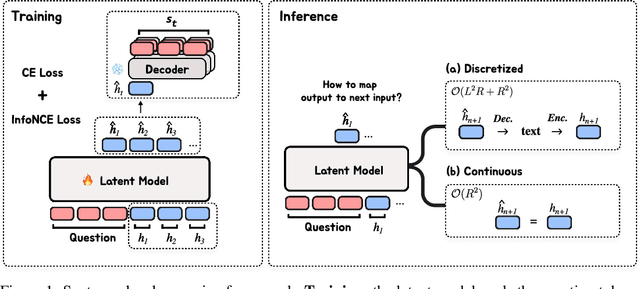


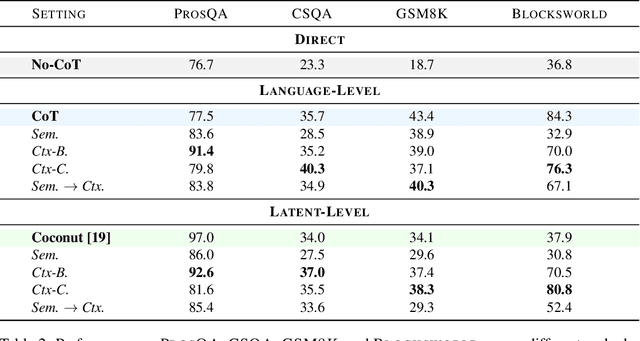
Abstract:Autoregressive language models (LMs) generate one token at a time, yet human reasoning operates over higher-level abstractions - sentences, propositions, and concepts. This contrast raises a central question- Can LMs likewise learn to reason over structured semantic units rather than raw token sequences? In this work, we investigate whether pretrained LMs can be lifted into such abstract reasoning spaces by building on their learned representations. We present a framework that adapts a pretrained token-level LM to operate in sentence space by autoregressively predicting continuous embeddings of next sentences. We explore two embedding paradigms inspired by classical representation learning: 1) semantic embeddings, learned via autoencoding to preserve surface meaning; and 2) contextual embeddings, trained via next-sentence prediction to encode anticipatory structure. We evaluate both under two inference regimes: Discretized, which decodes each predicted embedding into text before re-encoding; and Continuous, which reasons entirely in embedding space for improved efficiency. Across four domains - mathematics, logic, commonsense, and planning - contextual embeddings under continuous inference show competitive performance with Chain-of-Thought (CoT) while reducing inference-time FLOPs on average by half. We also present early signs of scalability and modular adaptation. Finally, to visualize latent trajectories, we introduce SentenceLens, a diagnostic tool that decodes intermediate model states into interpretable sentences. Together, our results indicate that pretrained LMs can effectively transition to abstract, structured reasoning within latent embedding spaces.
How Does Vision-Language Adaptation Impact the Safety of Vision Language Models?
Oct 10, 2024



Abstract:Vision-Language adaptation (VL adaptation) transforms Large Language Models (LLMs) into Large Vision-Language Models (LVLMs) for multimodal tasks, but this process often compromises the inherent safety capabilities embedded in the original LLMs. Despite potential harmfulness due to weakened safety measures, in-depth analysis on the effects of VL adaptation on safety remains under-explored. This study examines how VL adaptation influences safety and evaluates the impact of safety fine-tuning methods. Our analysis reveals that safety degradation occurs during VL adaptation, even when the training data is safe. While safety tuning techniques like supervised fine-tuning with safety datasets or reinforcement learning from human feedback mitigate some risks, they still lead to safety degradation and a reduction in helpfulness due to over-rejection issues. Further analysis of internal model weights suggests that VL adaptation may impact certain safety-related layers, potentially lowering overall safety levels. Additionally, our findings demonstrate that the objectives of VL adaptation and safety tuning are divergent, which often results in their simultaneous application being suboptimal. To address this, we suggest the weight merging approach as an optimal solution effectively reducing safety degradation while maintaining helpfulness. These insights help guide the development of more reliable and secure LVLMs for real-world applications.
Knowledge Entropy Decay during Language Model Pretraining Hinders New Knowledge Acquisition
Oct 02, 2024
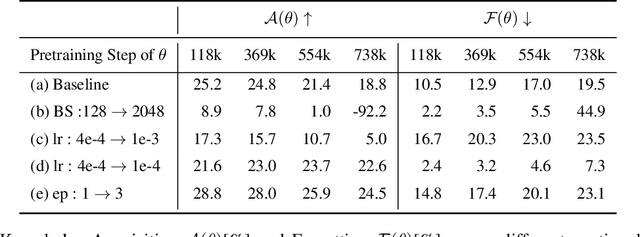
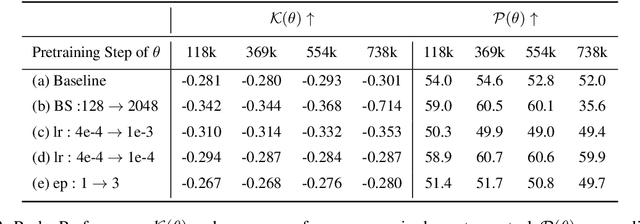

Abstract:In this work, we investigate how a model's tendency to broadly integrate its parametric knowledge evolves throughout pretraining, and how this behavior affects overall performance, particularly in terms of knowledge acquisition and forgetting. We introduce the concept of knowledge entropy, which quantifies the range of memory sources the model engages with; high knowledge entropy indicates that the model utilizes a wide range of memory sources, while low knowledge entropy suggests reliance on specific sources with greater certainty. Our analysis reveals a consistent decline in knowledge entropy as pretraining advances. We also find that the decline is closely associated with a reduction in the model's ability to acquire and retain knowledge, leading us to conclude that diminishing knowledge entropy (smaller number of active memory sources) impairs the model's knowledge acquisition and retention capabilities. We find further support for this by demonstrating that increasing the activity of inactive memory sources enhances the model's capacity for knowledge acquisition and retention.
PyGRF: An improved Python Geographical Random Forest model and case studies in public health and natural disasters
Sep 20, 2024Abstract:Geographical random forest (GRF) is a recently developed and spatially explicit machine learning model. With the ability to provide more accurate predictions and local interpretations, GRF has already been used in many studies. The current GRF model, however, has limitations in its determination of the local model weight and bandwidth hyperparameters, potentially insufficient numbers of local training samples, and sometimes high local prediction errors. Also, implemented as an R package, GRF currently does not have a Python version which limits its adoption among machine learning practitioners who prefer Python. This work addresses these limitations by introducing theory-informed hyperparameter determination, local training sample expansion, and spatially-weighted local prediction. We also develop a Python-based GRF model and package, PyGRF, to facilitate the use of the model. We evaluate the performance of PyGRF on an example dataset and further demonstrate its use in two case studies in public health and natural disasters.
ListT5: Listwise Reranking with Fusion-in-Decoder Improves Zero-shot Retrieval
Feb 28, 2024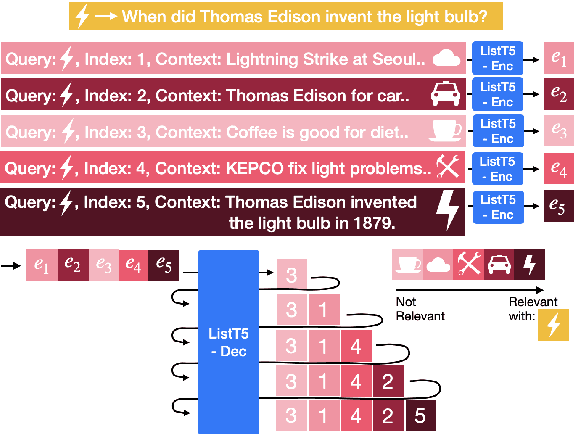
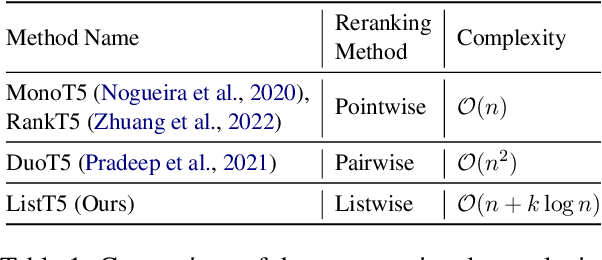

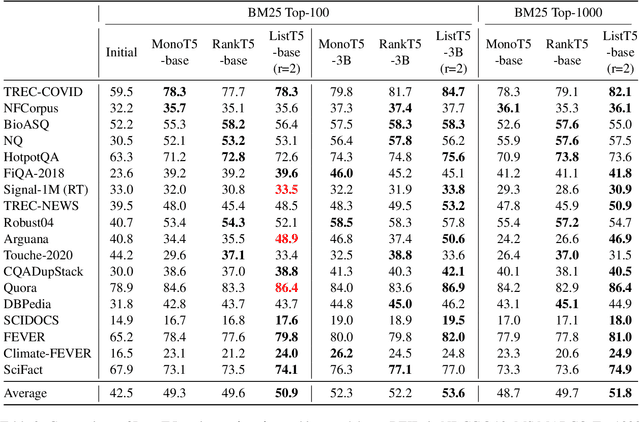
Abstract:We propose ListT5, a novel reranking approach based on Fusion-in-Decoder (FiD) that handles multiple candidate passages at both train and inference time. We also introduce an efficient inference framework for listwise ranking based on m-ary tournament sort with output caching. We evaluate and compare our model on the BEIR benchmark for zero-shot retrieval task, demonstrating that ListT5 (1) outperforms the state-of-the-art RankT5 baseline with a notable +1.3 gain in the average NDCG@10 score, (2) has an efficiency comparable to pointwise ranking models and surpasses the efficiency of previous listwise ranking models, and (3) overcomes the lost-in-the-middle problem of previous listwise rerankers. Our code, model checkpoints, and the evaluation framework are fully open-sourced at \url{https://github.com/soyoung97/ListT5}.
Data-driven grapheme-to-phoneme representations for a lexicon-free text-to-speech
Jan 19, 2024Abstract:Grapheme-to-Phoneme (G2P) is an essential first step in any modern, high-quality Text-to-Speech (TTS) system. Most of the current G2P systems rely on carefully hand-crafted lexicons developed by experts. This poses a two-fold problem. Firstly, the lexicons are generated using a fixed phoneme set, usually, ARPABET or IPA, which might not be the most optimal way to represent phonemes for all languages. Secondly, the man-hours required to produce such an expert lexicon are very high. In this paper, we eliminate both of these issues by using recent advances in self-supervised learning to obtain data-driven phoneme representations instead of fixed representations. We compare our lexicon-free approach against strong baselines that utilize a well-crafted lexicon. Furthermore, we show that our data-driven lexicon-free method performs as good or even marginally better than the conventional rule-based or lexicon-based neural G2Ps in terms of Mean Opinion Score (MOS) while using no prior language lexicon or phoneme set, i.e. no linguistic expertise.
A Unified Approach for Comprehensive Analysis of Various Spectral and Tissue Doppler Echocardiography
Nov 14, 2023
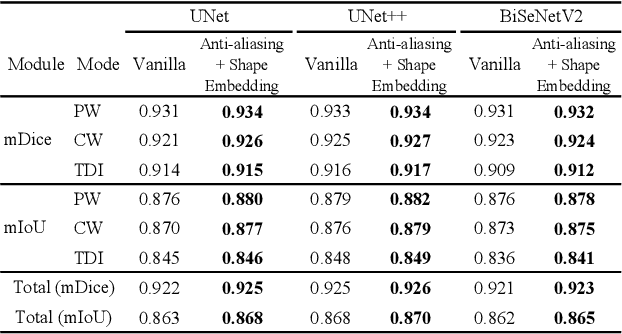
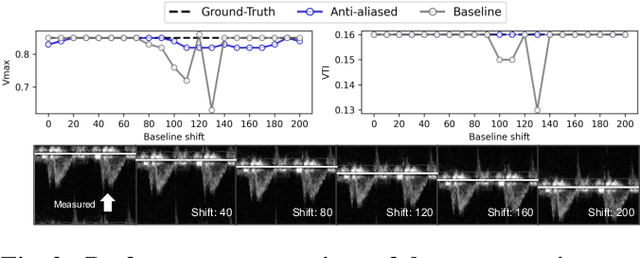
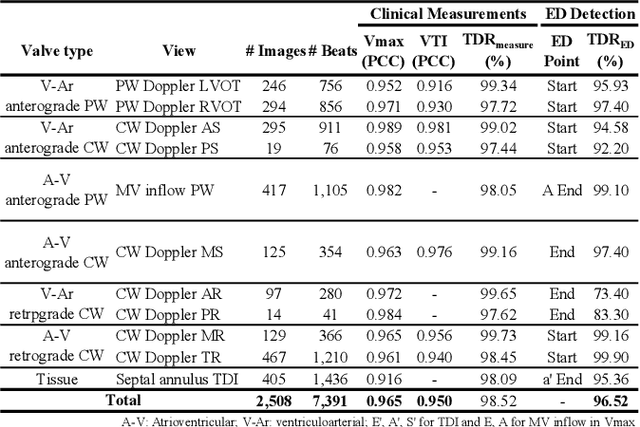
Abstract:Doppler echocardiography offers critical insights into cardiac function and phases by quantifying blood flow velocities and evaluating myocardial motion. However, previous methods for automating Doppler analysis, ranging from initial signal processing techniques to advanced deep learning approaches, have been constrained by their reliance on electrocardiogram (ECG) data and their inability to process Doppler views collectively. We introduce a novel unified framework using a convolutional neural network for comprehensive analysis of spectral and tissue Doppler echocardiography images that combines automatic measurements and end-diastole (ED) detection into a singular method. The network automatically recognizes key features across various Doppler views, with novel Doppler shape embedding and anti-aliasing modules enhancing interpretation and ensuring consistent analysis. Empirical results indicate a consistent outperformance in performance metrics, including dice similarity coefficients (DSC) and intersection over union (IoU). The proposed framework demonstrates strong agreement with clinicians in Doppler automatic measurements and competitive performance in ED detection.
Echocardiographic View Classification with Integrated Out-of-Distribution Detection for Enhanced Automatic Echocardiographic Analysis
Aug 31, 2023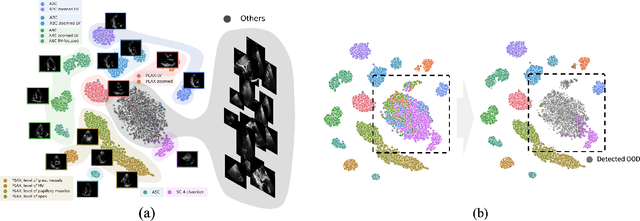



Abstract:In the rapidly evolving field of automatic echocardiographic analysis and interpretation, automatic view classification is a critical yet challenging task, owing to the inherent complexity and variability of echocardiographic data. This study presents ECHOcardiography VIew Classification with Out-of-Distribution dEtection (ECHO-VICODE), a novel deep learning-based framework that effectively addresses this challenge by training to classify 31 classes, surpassing previous studies and demonstrating its capacity to handle a wide range of echocardiographic views. Furthermore, ECHO-VICODE incorporates an integrated out-of-distribution (OOD) detection function, leveraging the relative Mahalanobis distance to effectively identify 'near-OOD' instances commonly encountered in echocardiographic data. Through extensive experimentation, we demonstrated the outstanding performance of ECHO-VICODE in terms of view classification and OOD detection, significantly reducing the potential for errors in echocardiographic analyses. This pioneering study significantly advances the domain of automated echocardiography analysis and exhibits promising prospects for substantial applications in extensive clinical research and practice.
 Add to Chrome
Add to Chrome Add to Firefox
Add to Firefox Add to Edge
Add to Edge